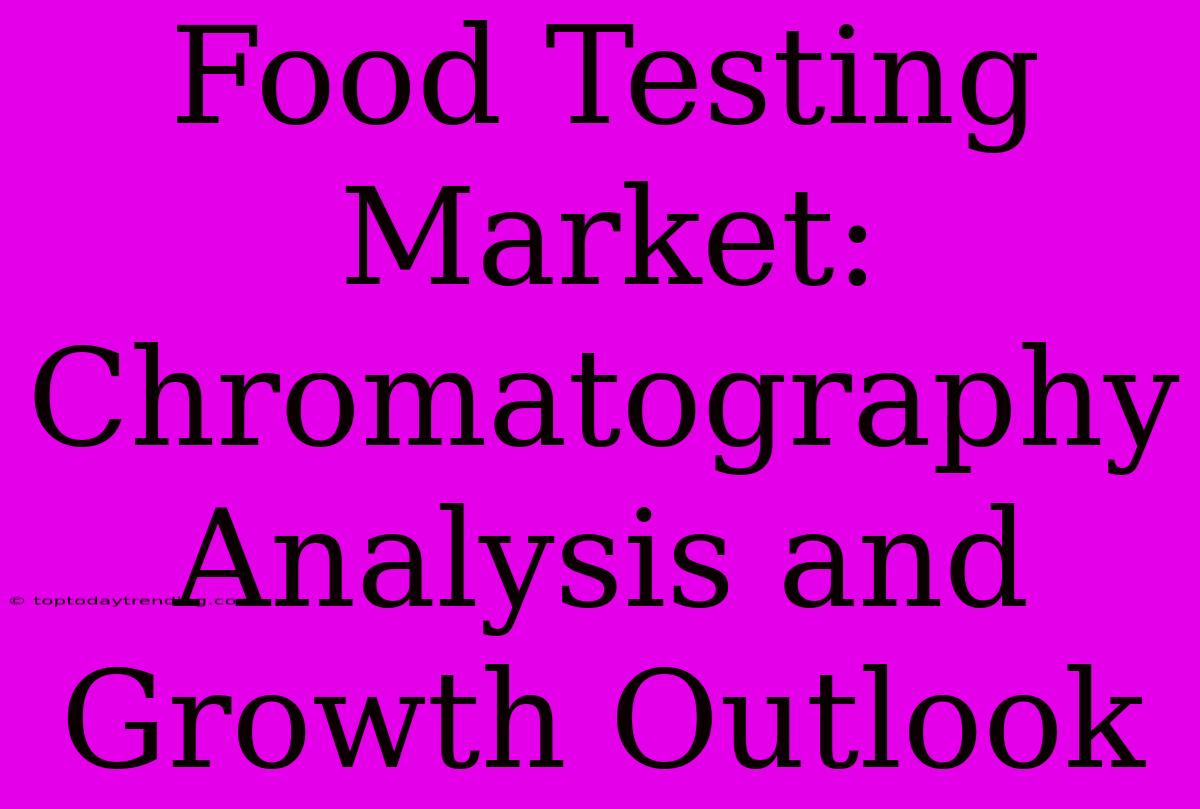Food Testing Market: Chromatography Analysis and Growth Outlook
The food testing market is a dynamic and ever-evolving industry, driven by increasing consumer awareness of food safety and quality, stringent regulatory standards, and the rising demand for food authenticity. Among the various analytical techniques employed in food testing, chromatography analysis plays a crucial role in identifying, quantifying, and characterizing various components in food products. This article will delve into the significance of chromatography analysis in the food testing market and explore its growth outlook.
Understanding Chromatography Analysis in Food Testing
Chromatography is a powerful analytical technique that separates different components of a mixture based on their physical and chemical properties. It is widely used in food testing for various applications, including:
- Pesticide residue analysis: Chromatography helps determine the presence and levels of pesticide residues in food products, ensuring they meet safety regulations.
- Food allergen detection: Identifying allergens like gluten, peanuts, and soy in food is crucial for preventing allergic reactions. Chromatography offers precise detection of these allergens.
- Antibiotic residue analysis: Detecting antibiotics in food products, especially in animal products, is vital for consumer safety. Chromatography analysis plays a significant role in this process.
- Food adulteration detection: This technique can uncover adulteration practices, such as the addition of non-food substances or the substitution of cheaper ingredients.
- Quality control analysis: Chromatography helps determine the presence and levels of specific compounds, such as vitamins, antioxidants, and other nutrients, ensuring product quality and consistency.
Types of Chromatography Techniques Used in Food Testing
Several types of chromatography techniques are commonly employed in food testing, each with its unique advantages:
- Gas Chromatography (GC): Ideal for volatile and semi-volatile compounds, GC is widely used in pesticide residue analysis, flavor profiling, and detection of contaminants.
- High-Performance Liquid Chromatography (HPLC): This technique is suitable for separating non-volatile compounds, making it effective for analyzing food additives, vitamins, and preservatives.
- Thin-Layer Chromatography (TLC): A relatively simple and cost-effective technique, TLC is used for initial screening, identification, and quantification of various compounds.
- Supercritical Fluid Chromatography (SFC): SFC offers an environmentally friendly alternative to conventional chromatography, particularly for analyzing food components with complex structures.
Growth Drivers and Market Trends
The global food testing market is projected to witness significant growth in the coming years, fueled by various factors:
- Rising Consumer Awareness: Consumers are increasingly demanding safe and healthy food products, driving the need for rigorous testing.
- Stringent Regulatory Standards: Governments worldwide are enforcing stricter regulations regarding food safety, leading to increased demand for food testing services.
- Technological Advancements: The development of sophisticated analytical techniques like chromatography has enabled faster, more accurate, and cost-effective food testing.
- E-commerce Growth: The rise of online food delivery and e-commerce platforms further necessitates robust food safety measures, driving the need for testing.
- Food Fraud and Adulteration Concerns: Growing incidents of food fraud and adulteration have prompted authorities and consumers to prioritize food authenticity testing.
Future Outlook: Innovations and Advancements
The food testing market is continuously evolving, with a focus on innovation and advancements:
- Automation and High-Throughput Screening: Automated chromatography systems are being developed to enhance efficiency and reduce manual labor in food testing labs.
- Miniaturization and Portable Devices: Compact and portable chromatography devices are being developed for on-site testing, enabling rapid results and on-the-go analysis.
- Combined Techniques: Integration of chromatography with other analytical techniques like mass spectrometry (MS) provides comprehensive and accurate analysis of food components.
- Artificial Intelligence (AI) and Machine Learning: AI-powered algorithms are being implemented to automate data analysis and interpretation in chromatography, improving efficiency and accuracy.
Conclusion
Chromatography analysis plays a crucial role in ensuring food safety, quality, and authenticity. The food testing market is expected to grow significantly in the coming years, driven by increasing consumer awareness, stringent regulations, and advancements in analytical technologies. By utilizing innovative chromatography techniques, food industries and regulatory bodies can effectively address food safety concerns and protect consumers from harmful substances. The future of food testing looks bright, with continued advancements in chromatography driving further progress and innovation in the field.

